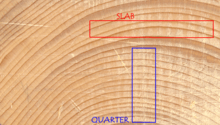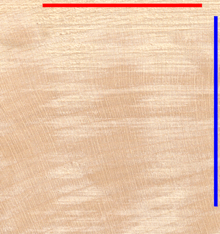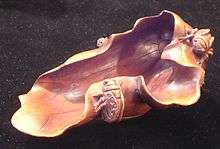Wood art

As a contemporary artistic medium, wood is used in traditional and modern styles, and is an excellent medium for new art. Wood is used in forms of sculpture, craft, and decoration including chip carving, wood burning, and marquetry. Wood offers a fascination, beauty, and complexity in the grain, that often shows even when the medium is painted. Wood is used by carpenters to create many useful items such as cabinets, furniture and musical instruments. Artists use wood for sculpture because it is plentiful and inexpensive when compared to other media like stone or bronze. It is in some ways easier to shape than harder substances, but an artist must develop specific skills to carve it properly. Wood does not last as long as other sculpting media because it can be affected by water rot, dry rot, insect invasion and fire.
One popular form of wood art production is woodturning. Woodturning on a simple lathe, such as a bow lathe or two-person lathe, primarily for practical purposes has occurred since as early as 1300 B.C. Edward S. Cooke, Jr. points out, "During the economic crises of the 1930s, industrial arts education became more vocational in purpose." [1] From the 1930s, the field of wood turning grew from this hobbyist movement in the 1930s to fine artists in the 1970s, experimenting with super object forms and other fine craft concepts.[1] At present, there are a variety of international galleries exhibiting wood art, including The Center for Art in Wood in Philadelphia, which houses a museum collection and research library in addition to rotating gallery exhibitions. [2]
Grain


A person who begins woodcarving is challenged to learn to work with the fiber and grain. Hardness and fragility vary with the species of wood. In general, wood tends to break in the "split direction", the direction in which the fibers separate. In the composition of work, one must work with and around this. Each direction of cut feels and works differently. Sharp tools are essential in allowing the artist's sense to shape the material.
Planks of wood are said to be quarter-sawn when the growth rings are more or less at right angles to the thickness. If the growth rings are more parallel to the width, then the plank is said to be slab-cut. While slab-cut planks are seasoning, they tend to cup in a direction so as to "straighten" the growth rings.[3]
Seasoned wood never completely stabilizes, but continues to swell and shrink with seasonal humidity and temperature variations. Any design concept using wood must allow for the particulars of this dimensional variation. Warped wood may be described as bent, twisted, or cupped, or some combination of those modes.
Species
Here are just a few commonly used hardwood and softwood species; many more may be found in List of woods. Each has its own character.
Hardwood
- Balsa (Ochroma) is technically a hardwood, but is actually softer than most softwoods and very easily shaped. Its most familiar use is in model airplanes.
- Basswood (Tilia) also known as lime or linden, is a relatively soft, close-grained wood, easily carved.
- Birch (Betula) is a light-colored, fine-grained wood.
- Elm (Ulmus) is notorious for its twisting, intertwined grain.
- Maple (Acer) may be seen in a variety of figures known as curly maple, including tiger-stripe or "fiddleback", bird's-eye and quilted.
- Oak (Quercus) species are typically dense, hard and show distinctive pores and medullary rays.
- Walnut (Juglans) is typically dark, hard, tight-grained wood prized for fine furniture and wood paneling.
Softwood
- Cedar (Cedrus) is fairly hard and aromatic.
- Fir (Abies) is soft and white.
- Pine (Pinus) is a fast-growing wood grown commercially for use in construction and paper pulp industries.
- Spruce (Picea) is used for the soundboards of musical instruments as well as in aviation construction.
Fastening and Joining
See Woodworking joints and Adhesives.
Finishing
The grain and figure of the wood interact with the shape of the piece to make interesting visual and tactile effects. The surface texture may be manipulated by sanding, scraping, scorching, weathering, or leaving it just as it came from the shaping. Processes such as sanding or rasping have one sort of effect, while cutting (planing, chiseling, gouging, or other carving) leaves the surface with a distinctively clear and fresh appearance, particularly if the tool is well-sharpened. Some finishing processes may leave a corduroy effect, where the lines of harder late wood contrast with the often paler, softer, early wood.
Each tool used to shape wood usually leaves a signature, or distinctive set of marks. For example, it is easy to tell a cut made by a bandsaw from that of a circular saw. If a smooth surface is desired, then planes, scrapers, or sandpaper are useful for "erasing" toolmarks. Sometimes it is more interesting to leave the tool marks showing. Some centuries-old violin scrolls, for instance, still carry the tool marks of the master that made them, working rapidly and efficiently.
The texture and appearance of wood grain may be enhanced and preserved by the use of an appropriate coating process, either transparent, such as varnish or opaque, like paint. The finish coats may also help seal the surface, reducing the adverse effects of humidity or sunlight. Other pieces may benefit from the use of unsealed, weathered material such as barn wood or driftwood.
Tools and sharpening
Working with wood pertains mainly to "cutting away the material that doesn't look like the object in mind." Saws, rasps, chisels, gouges and knives are all useful, and must be well sharpened to work effectively and safely. Dull tools are actually more dangerous than sharp ones; excessive force used on a dull edge can lead to slips and injury.
See also
- Cabinet making
- Carpentry
- Ébéniste
- Marquetry
- Parquetry
- Segmented turning
- Wood carving
- Woodturning
- Woodworking
References
- 1 2 Woodturning in North America Since 1930. Wood Turning Center and Yale University Art Gallery. 2001. pp. 15–17; 64. ISBN 0-89467-094-8.
- ↑ "About | The Center for Art in Wood". centerforartinwood.org. Retrieved 2015-10-13.
- ↑ http://www.fpl.fs.fed.us/documnts/pdf1983/simps83a.pdf
External links
- Wood art inspired in Islamic patterns
- http://www.chipchats.org/
- LathArt How to and Patterns
- http://www.chasens.ca/en/green_new_art.html
- http://sweb1.dmit.nait.ca/~jtoews6/inlay-woodworking-projects/
